|
Home
Introduction
to NOUFORS
What's
New
Products
Michel
M. Deschamps - Director
Personal
Sightings
Sightings
Archive
Newspaper
Archive
UFOs
UFO
Characteristics
UFO
Physical Traces
Animal
Mutilations
UFO
Occupants
Crop
Circles
Audio
Clips
Documents
Majestic-12
Politicians
and UFOs
Military
Officers
and UFOs
Scientists
and UFOs
Astronauts
and UFOs
Pilots
and UFOs
Cops
and Saucers
Celebrities
and UFOs
Who's
Who in
UFOlogy
Skeptics
and Debunkers
Encyclopedia
of Terminology and Abbreviations
Kidz'
Korner
Links
Recommended
Reading
Recommended
Viewing
|
|
|
|
Theories
and False Explanations for UFOs
|
Throughout
the modern age of flying saucers and UFOs, authorities
from the scientific community and the military establishment
have put forth several theories and proasic explanations
for UFO sightings.
Leading
skeptics and debunkers also take advantage
of these explanations as quick-fix solutions to explain
away what people have been reporting for years.
Planets
and Stars
Northern Lights
Sprites,
Elves and Blue Jets
Weather Balloons, Skyhook Balloons and other atmospheric
devices
Temperature Inversion
Lenticular Clouds
Hole-Punch Clouds or Fallstreak Hole
Lens Flare and Green Orbs (with white specks)
Iridium Flare
Sun Dogs and Moon Dogs
Ball Lightning
Swamp Gas
St. Elmo's Fire
Earthquake Lights
Swarm of Glowing Insects
Satellites and the International Space Station
Comets
Shooting Stars, Meteors, Fireballs and Bolides
Fireworks
Chinese lanterns
Aircraft and UAVs
Drones
Military
Flares
|
|
|
Planets
and Stars
If,
by any chance, the sighting lasts beyond thirty minutes,
I would then record the additional length of time that the
object is in sight. If the object is nothing more than a
bright source of light that isn't moving, I would suggest
that you go outside on consecutive nights and see if the
object is still visible at the same location and around
the same period of time; if it is, then what you are looking
at is a planet!
It
is easy to make the distinction between planets and stars.
For instance, planets are extremely bright because of their
close proximity to us. And because of their brilliance,
they are not affected by our atmosphere and they do not
twinkle or blink.
Stars,
on the other hand, will twinkle in the night sky due to
the fact that they are very far away, and the atmosphere
that is located between us and them easily affects the visibility,
preventing us from having a clear view of them.
|
|
|
Northern
Lights
Northern
Lights are an atmospheric phenomenon consisting of bands
of light caused by charged solar particles following the
earth's magnetic lines of force.



Northern
Lights
Northern
lights look more like curtains of colours and could not
possibly take on the shape of a UFO, nor do they behave
like one.
|
|
|
Sprites
Sprites
are luminous flashes occurring in the mesosphere, above
the cumulonimbus. Approximately 1 storm out of 20 will be
powerful enough to generate them up to altitudes of 90 kilometers
over a width of 15 kilometers.

First
color image of a sprite
Elves
Elves
can appear with sprites, but always by preceding them, and
their duration is more transitory. They are the electromagnetic
impulses released by the powerful flashes from which originate
the Elves. From lightning, these impulses are propagated
in every direction at the speed of light. When the upper
part of this "sphere" reaches a critical altitude
located between 75 and 100 kilometers, the electrical field
conveyed by these impulses then will accelerate the electrons.
The latter will strike the gas molecules and will excite
them in such a way that they will emit a surplus of light
energy in the form of a ring, resulting from the intersection
between the spherical propagation and the critical layer.
The phenomenon occurs in a manner so fast that this ring
will be seen like a flattened disc.
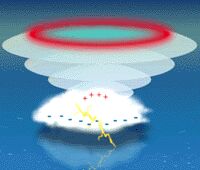

Elves
Blue
Jets
Blue
Jets were observed for the first time in 1994. These conical
jets of night-blue light are propagated from the top of
the clouds going higher, at a speed approximately 120 kilometers
a second and never seems to exceed an altitude of 40 kilometers.


Blue
Jets
|
|
|
Weather
Balloons, Skyhook Balloons and other atmospheric devices
A
weather balloon is used to carry instruments aloft to gather
meteorological data in the atmosphere.

Project
Skyhook
In
1947, the U.S. Navy began Project Skyhook, which
used very large unmanned plastic (polyethylene) balloons
to loft research payloads of various kinds (e.g. cosmic
ray research) to altitudes of up to 30 km (100,000 ft).
The initial prime contractor for the Navy's Skyhook
balloons was the Aeronautical Division of General Mills,
Inc. Skyhook eventually became a very successful
program, and its balloon technology was also used by the
Air Force. In fact, the name Skyhook became a synonym
for large high-altitude plastic balloons, even if they were
launched by other agencies under different programs.

Photo:
Office of Naval Research
Skyhook balloon
At
low level immediately after launch, the lifting gas (hydrogen
or helium) in Skyhook balloons formed a small bubble
at the top of the envelope, giving the whole balloon a rather
"limp" look. At the lower air pressure at higher
altitudes, the gas expanded and eventually filled the whole
envelope, which could reach diameters of more than 30 m
(100 ft) in some balloon models. High-flying Skyhook
balloons provided an excellent stimulus for UFO/"Flying
Saucer" sightings, and several balloons, which were
lost by the military's visual and radar tracking systems,
were "tracked" by following local UFO reports
across the continent.
Project
Mogul
Project
Mogul (sometimes referred to as Operation Mogul)
was a top secret project by the US Army Air Forces involving
high altitude balloons, whose primary purpose was long-distance
detection of sound waves generated by the turbulence of
the rising hot air from Soviet atomic bomb tests and ballistic
missiles. The project was carried out from 1947 until late
1948 and was obsoleted by seismographs and spy satellites.
Project
Gopher
When
the Cold War began soon after the Second World War, U.S.
military planners had the problem that they had virtually
no information about what was going on in vast areas of
the Soviet territory. Photo reconnaissance aircraft were
used to obtain coverage of areas near the borders, and there
were even very few overflights of the Soviet interior in
the early 1950s. But these missions were extremely risky,
and couldn't provide enough information for a good assessment
of Soviet military strength. Satellites were still too far
in the future, and therefore reconnaissance balloons were
proposed as a solution for the problem.
In
July 1950, Charles B. Moore of General Mills had conducted
four test flights of Skyhook-type balloons with a
camera payload. To the U.S. Air Force he presented the concept
of camera-equipped balloons, which could float across the
Soviet Union using strong winds (the "jet stream")
at very high altitude, above the reach of Soviet air defences.
In November 1950, the USAF officially began the development
of a balloon reconnaissance system under secret project
MX-1594 Gopher.
Design
goal for Project Gopher was a balloon, which could
carry a 225 kg (500 lb) payload gondola to 21000 m (70,000
ft), and remain there at constant altitude for at least
16 days. Originally it had been hoped that Gopher
could conduct the first operational missions by the end
of 1951, but this proved to be far too optimistic. A series
of test flights in 1952 was only partially successful, mainly
because of continuing problems during balloon launch and
with payload reliability. Because the USAF was dissatisfied
with General Mills' progress, the balloon production contract
was terminated in August 1952, and further balloons were
ordered from Winzen Research. Project Gopher was
a top secret project, but the balloon test flights could
obviously not be hidden from the public. Therefore all test
flights were officially part of Project Moby Dick
(MX-1498), the USAF's unclassified research balloon
project. Moby Dick had been started around the same
time as Gopher, and used Skyhook balloons
to measure global high-altitude wind patterns. Gopher's
camera gondolas, which could parachute to earth anywhere
after a test flight, were accordingly labeled as Air Force
property (together with a fire hazard warning to discourage
potential souvenir hunters).

Drawing:
USAF
Typical
Gopher balloon layout
WS-119L
In
July 1953, the USAF finally decided to develop Gopher
into the WS-119L operational balloon reconnaissance
system, codenamed Grandson. In spring 1955, WS-119L
was finally ready for operational training, and the program's
code name was changed again, to Grayback. Between
May and October that year, more than a hundred WS-119L balloons
were launched under operation "Moby Dick Hi" (as
usual, the Moby Dick name was used as cover). Although only
11 successful mid-air recoveries were made in 33 attempts,
WS-119L was considered ready for use at the end of 1955.
President Eisenhower gave approval to begin the overflights
in January 1956, but had the flight altitude of the balloons
limited to 16800 m (55,000 ft). This was reportedly done,
because the higher-flying Lockheed U-2 aircraft was under
development at that time, and the Soviets should get no
unnecessary motivation to develop new very high-altitude
interceptor aircraft and missiles before the U-2 had begun
its overflight program.

Photo:
Robert Burch
Launch
of WS-119L balloon
Whether
we're talking ordinary weather balloons or the types launched
by the Navy, these objects go up and down and are at the
mercy of the winds. They cannot move from side to side,
hover or even accelerate from 0 to 10,000 miles an hour
(or more) like UFOs do.
|
|
|
Temperature
Inversion
A
temperature inversion is a meteorological condition that
happens on clear, cold, still evenings and is caused by
radiation cooling of the ground which occurs faster than
the cooling of the air right above ground giving you a layer
of warm air above cooler air. This prevents pollutants and
other airborne substances from escaping into the atmosphere.
|
|
|
Lenticular
Clouds
Lenticular
clouds, technically known as altocumulus standing lenticularis,
are stationary lens-shaped clouds that form at high altitudes,
normally aligned at right-angles to the wind direction.


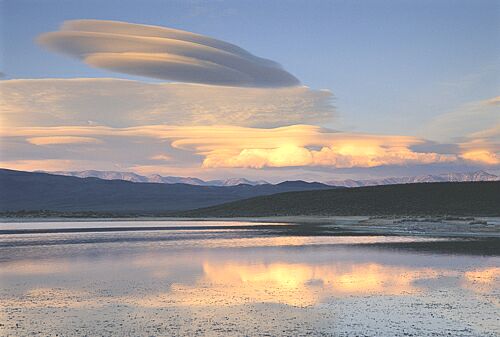
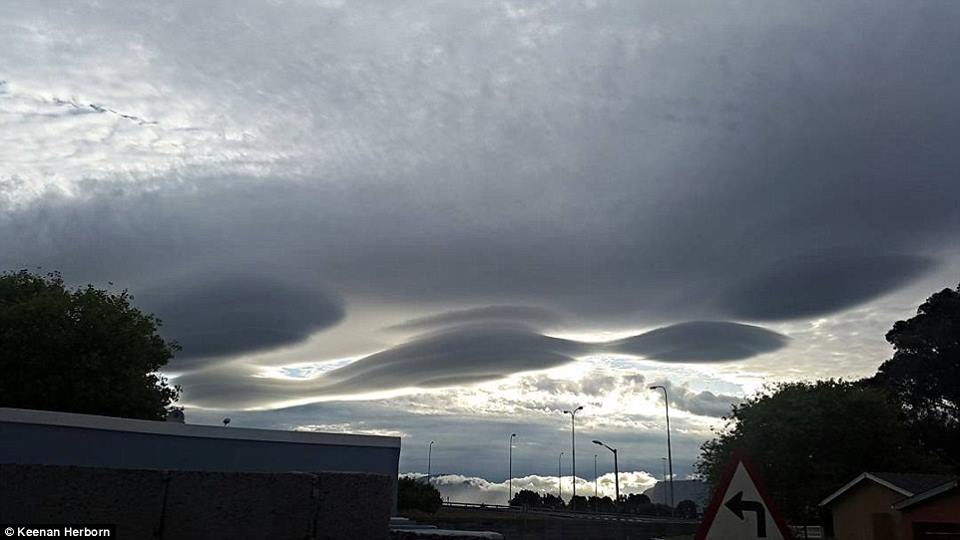
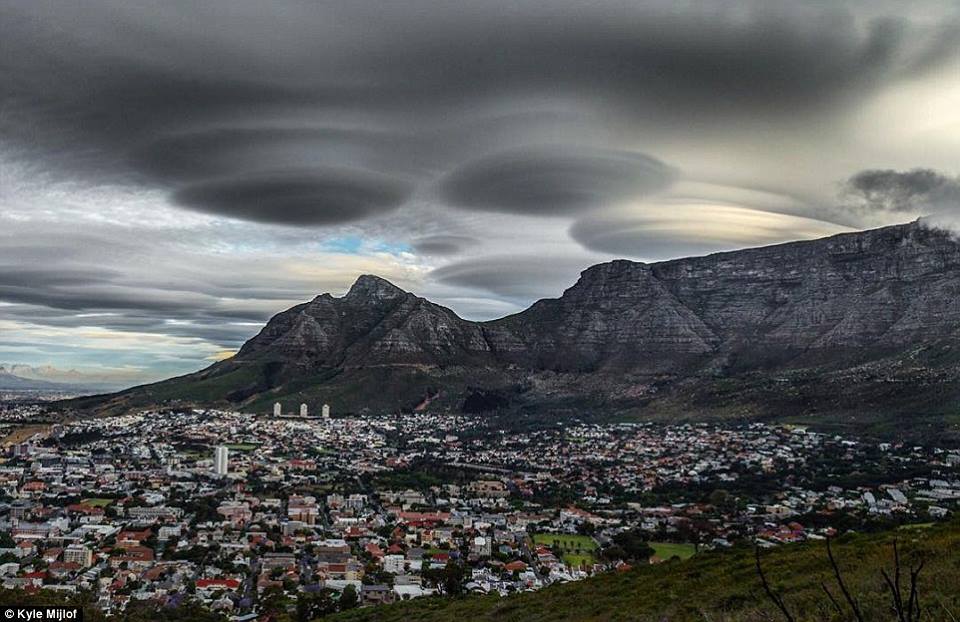

|
|
|
Hole-Punch
Clouds or Fallstreak Hole
A
leading hypothesis holds that the hole-punch cloud is caused
by falling ice-crystals. The ice-crystals could originate
in a higher cloud or be facilitated by a passing airplane
exhaust. If the air has just the right temperature and moisture
content, the falling crystals will absorb water from the
air and grow. For this to happen, the water must be so cold
that all it needs is a surface to freeze on. The moisture
lost from the air increases the evaporation rate from the
cloud water droplets so they dissipate to form the hole.
The now heavier ice crystals continue to fall and form the
more tenuous wispy cloud-like virga seen inside and just
below the hole. Water and ice from the virga evaporates
before they reach the ground.


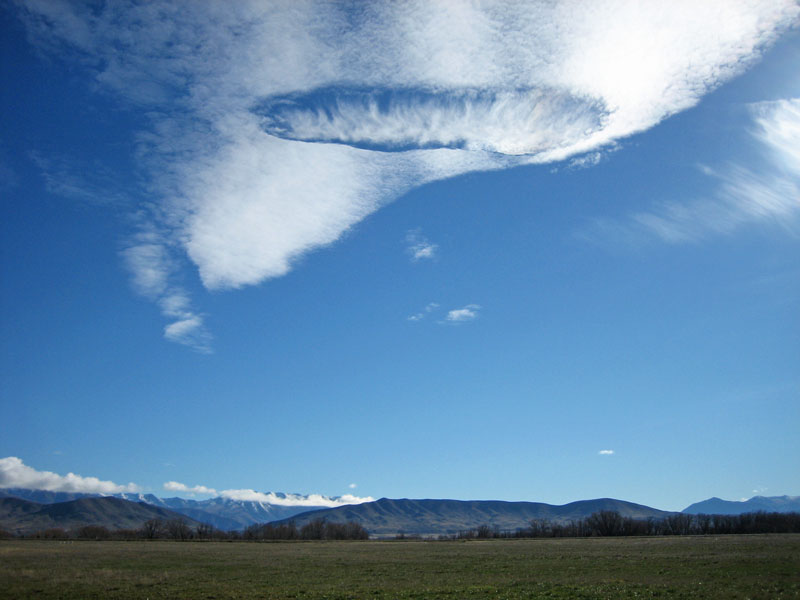

From
left to right: A hole-punch cloud
over Mobile, Alabama - December 11, 2003; A hole-punch cloud
over Alabama - January 12, 2004;
A fallstreak hole visible over Omarama, New Zealand in May
2006 and a
fallstreak hole over Austria - August 2008.
|
|
|
Lens
Flare and Green Orbs (with white specks)
Lens
flare is created when non-image forming light enters
the lens and subsequently hits the camera's film or digital
sensor. This often appears as a characteristic polygonal
shape, with sides which depend on the shape of the lens
diaphragm.

Photograph
of NASA lunar lander containing lens flare.
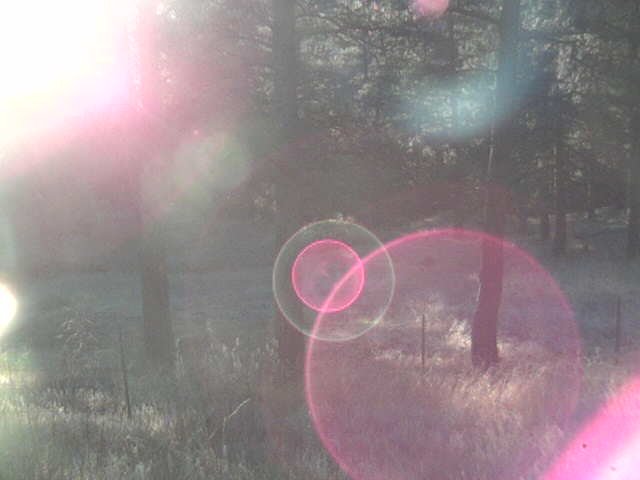
Lens
flare in a CCTV camera.
Cell
phones will produce a different lens flare effect known
as "Green Orbs". These images are usually
the result of photographs taken while the sun is in plain
sight of the photographer and they depict a green or bluish-green
orb with tiny white specks that appear to be inside the
orb, or stuck to it. The majority of the images seen so
far seem to be from Galaxy S5 or S6 phones. S7 phones will
make an orb, but with no dots. They have not been seen on
an iPhone.

Source:
https://www.metabunk.org/orbs-with-dots-pdaf-focus-pixels-in-sun-reflection-lens-flare.t8872/
|
|
|
Iridium
Flare
An
Iridium flare is a specific type of satellite flare (also
known as satellite glint) made when the antennas of an Iridium
communication satellite reflect sunlight directly onto the
surface of the Earth. Whoever is looking at the right spot
at the right time will see a brief but bright flare in the
sky which is sometimes brighter than Venus and even the
Moon (when it's not full). However, you don't have to depend
on sheer luck to see an Iridium flare. With data giving
the location of the satellites around the Earth, a program
can easily calculate the time at which an observer will
see the sun's reflection on the antennas.




Iridium
Flare in Real Time.mp4
|
|
|
Sun
Dogs and Moon Dogs
A
sun dog (scientific name parhelion, plural parhelia,
i.e. "beside the sun") is a common bright circular
spot on a solar halo. It is an atmospheric optical phenomenon
primarily associated with the reflection or refraction of
sunlight by small ice crystals making up cirrus or cirrostratus
clouds. Often, two or more sundogs can be seen on opposite
sides of the sun simultaneously. Sometimes called "Mock
Suns".


Sun
dogs
These
patches of light are occasionally seen around a very bright,
full moon. In that case, they are called moon dogs.


Moon
dogs
Sometimes,
a luminous circle or halo can be seen around the
sun or moon, and is caused by the refraction of light through
crystals of ice in the atmosphere. There are often white
bands, crosses, or arches connected with halos, resulting
from the same atmospheric conditions.

Moon
halo
|
|
|
Ball
Lightning
Ball
Lightning (BL or Kugelblitz, Boules de Feu) is recognised
by science but has eluded attempts at a generally accepted
explanation. It can range from high intensity ones like
this one through to semi-transparent orbs or other shapes
of white or coloured plasma light. Earth Lights may be of
a similar nature or perhaps of another kind of process altogether.
Ball Lightning occurs most often during thunderstorm activity.


Having
once been a witness to ball lightning, which is a rare event
in itself, I can tell you that the phenomenon doesn't last
more than a few seconds and could not possibly account for
any UFO sighting because of the way it looks and behaves.
|
|
|
Swamp
Gas
Swamp
gas or marsh gas is a gaseous product, chiefly methane,
formed from decomposing vegetable matter, as in marshes.
The late J. Allen Hynek had used the term "swamp gas"
to explain away a rash of UFO sightings that took place
in Michigan in 1966. It is said that he later regretted
this statement when he became convinced that there was something
to UFOs.
|
|
|
St.
Elmo's Fire
St.
Elmo's fire is a popular name for so-called coronal discharge,
which frequently happens during thunderstorms. Unlike lightning,
coronal discharge is much less spectacular and less transient
in nature. It looks like a blueish flame or glow engulfing
tall sharp objects, such as powerlines, roof pinnacles,
chimneys, and lightning rods. Unless the electric field
is extremely strong, the glow is only visible at night,
but can still be heard during the day as a hissing or crackling
sound.


St
Elmo's fire, or coronal discharge, is a weakly luminous
continuous
discharge caused by strong electric fields near sharp objects.
|
|
|
Earthquake
Lights
Earthquake
lights are a strange luminous phenomena that
preceeds earthquakes. They have also been used as an explanation
for some of the UFO reports in the recent past. But once
you compare the behavior of these lights with that of UFOs,
you will notice a distinct diference between the two phenomena.


Luminous
phenomena at Tianshui, Gansu Province,
just before an earthquake - May 12 2008.
Dr.
Michael Persinger, neuroscientist at Laurentian University
here in Sudbury, Ontario, offered the tectonic strain theory
or Earthlight
theory to explain away UFO sightings. Most
scientists have disagreed with his theory and are not even
contemplating the idea that such lights of short duration
can account for UFO sightings.
|
|
|
Swarm
of Glowing Insects
As
crazy as it sounds, a "swarm of glowing insects"
indeed was used as an explanation for the reported sightings
of flying saucers in the 1940s and 1950s. But as we all
know, fireflies cannot sustain a continuous glow, nor can
they fly at high speeds at altitudes in excess of 10,000
feet.
|
|
|
Satellites
and the International Space Station
A
satellite is any object, man-made or natural, that orbits
the Earth. In the context of spaceflight, a satellite is
an object which has been placed into orbit by human endeavor.
Such objects are sometimes called artificial satellites
to distinguish them from natural satellites such as the
Moon.
To
the naked eye, satellites will appear as a single light
source with the same brilliance as a star. These objects
move in a straight trajectory, as they follow the curvature
of the earth within their respective orbits. They are always
white in color and there are no flashing lights visible.
Geosynchronous
satellite
Also
called geostationary, or simply GEO, it refers
to the movement of communications satellites where the satellite
circles the globe over the equator, in a movement that is
synchronized with the earth's rotation. Because of this
synchronization, the satellite appears to be stationary,
and they also offer continuous operation in the area of
visibility. These types of satellite are said to have a
geostationary orbit, and it is the most common type
of orbit for communications satellites. Bird is the
slang term given to a communications satellite that is in
geosynchronous orbit.
The
International Space Station
Orbiting
some 240 miles above the Earth, it's one of the brightest
objects in the night sky, comparable in size to Venus or
Jupiter. And just like artificial satellites, it moves in
a straight trajectory and does not have any flashing lights.
|
|
|
Comets
Comets
are small Solar System bodies that orbit the Sun and, when
close enough to the Sun, exhibit a visible coma (or atmosphere)
and/or a tail — both primarily from the effects of
solar radiation upon the comet's nucleus. Comet nuclei are
themselves loose collections of ice, dust and small rocky
particles, measuring a few kilometres or tens of kilometres
across.
Comets
originate in the outer solar system; they are thrown inwards
towards the Sun by gravitational perturbations from planets
or nearby stars. They have a variety of different orbital
periods, ranging from a few years, to 50 or 100 years, to
thousands of years, while some are believed to pass through
the inner Solar System only once before being thrown out
into interstellar space.
The
comets move through the sky on an extent of several days.



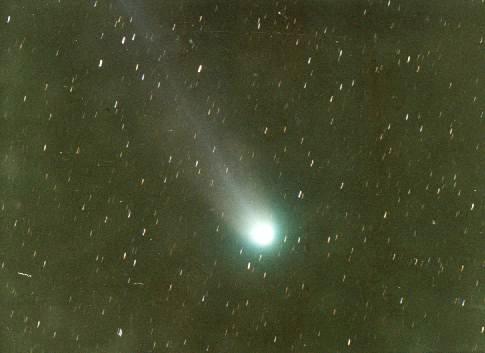
Comet
Hyakutake (March, 1996)




Comet
Hale-Bopp (April, 1997)
|
|
|
Shooting
Stars, Meteors, Fireballs and Bolides
A
shooting star or meteor is a streak of light
in the sky at night that results when a meteoroid hits the
earth's atmosphere and air friction causes the meteoroid
to melt or vaporize or explode.
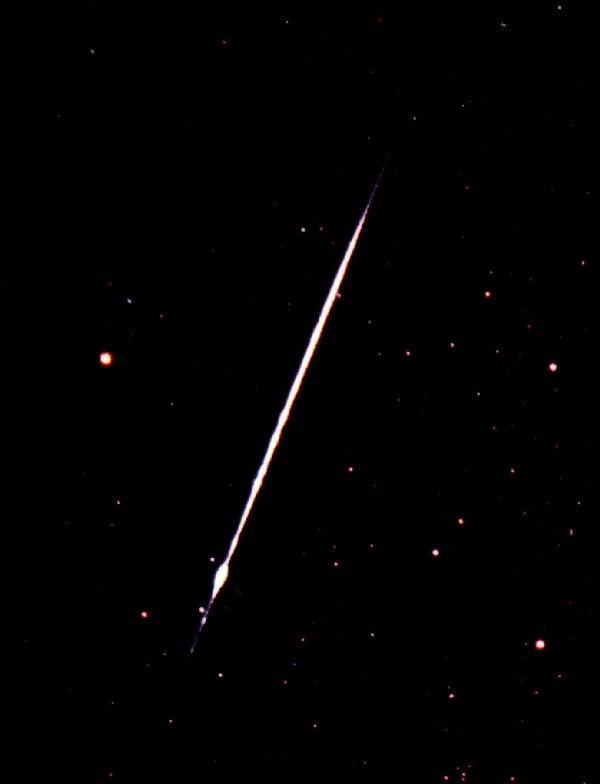
A
Perseid meteor passes close to the red star Epsilon Eridani.
A
meteoroid
is a small sand to boulder-sized particle of debris in the
Solar system. The visible path of a meteoroid that enters
Earth's (or another body's) atmosphere is a meteor, commonly
called a "shooting star" or "falling star".
Many meteors are part of a meteor shower. The root word
meteor comes from the Greek meteo-ros, meaning high in
the air.
A
fireball is brighter than a usual meteor. The International
Astronomical Union defines a fireball as "a meteor
brighter than any of the planets" (magnitude -4 or
greater). Usually,
fireballs streak across the sky in a matter of seconds,
but can leave a faint ionization trail visible for minutes.

Fireball
Astronomers
tend to use the term bolide to mean an exceptionally
bright fireball, particularly one that explodes (sometimes
called a detonating fireball).

Bolide
A
meteorite is a portion of a meteoroid or asteroid
that survives its passage through the atmosphere and impact
with the ground without being destroyed. Meteorites are
sometimes, but not always, found in association with hypervelocity
impact craters; during energetic collisions, the entire
impactor may be vaporized, leaving no meteorites.
|
|
|
Fireworks
Fireworks
are a class of explosive pyrotechnic devices used for aesthetic,
cultural, and religious purposes. A fireworks event (also
called a fireworks show or pyrotechnics) is a display of
the effects produced by firework devices. Fireworks competitions
are also regularly held at a number of places. Fireworks
take many forms to produce the four primary effects: noise,
light, smoke and floating materials (confetti for example.)
They may be designed to burn with flames and sparks of many
colors, typically red, orange, yellow, green, blue, purple,
silver and gold. Displays are common throughout the world
and are the focal point of many cultural and religious celebrations.
UFO
sightings have been reported before, during and after a
fireworks display on a few occasions. If such an event should
occur again, I would recommend that that the witnesses take
note of the details of their observation in order to distinguish
a true UFO from a display of fireworks. Here are a few examples
of fireworks displays:








|
|
|
Chinese
Lanterns
Chinese
lanterns have either been used to explain away some UFO
sightings ... or ... they've been misidentified as UFOs
due to the lack of observational experience on the part
of the observer. These devices are very light in construction,
illuminated from within, and will float in whatever direction
the wind is blowing in. At higher altitudes where the winds
are stronger and multi-directional, the lanterns can pick
up speed and be swept away, seemingly going against the
wind's direction.
UFOs
have been known to fly against the wind, or even hover during
very windy conditions, day or night.

Chinese lanterns
|
|
|
Aircraft
and UAVs (Unmanned Aerial Vehicles)
Unless
you are unfamiliar with aircraft and how they appear in
the night sky, determining whether or not you are looking
at an airplane or at a UFO can easily be accomplished.
Light
Configurations On Aircraft
At
first sight, it is true that it can be difficult to tell
the difference between a UFO and a common object such as
a plane or a helicopter during the night. But once you've
become accustomed to seeing aircraft at night, it'll be
a cinch to do so.
In
order to easily distinguish a UFO from a man-made aircraft,
it is important to be able to recognize aircraft by their
light patterns and configurations.

The
CIA has claimed that during the 1960s, sightings of UFOs
were attributed to flights of the U2 Spy Plane. If one is
to take a closer look at this aircraft, the first noticeable
feature of this aiplane are its large wings. The simple
fact that the U2 flew at extremely high altitudes made it
impossible for anyone to see it from the ground. And the
shape of it is easily recognizable...unlike that of a UFO,
which is why it is called an Unidentified flying
object.

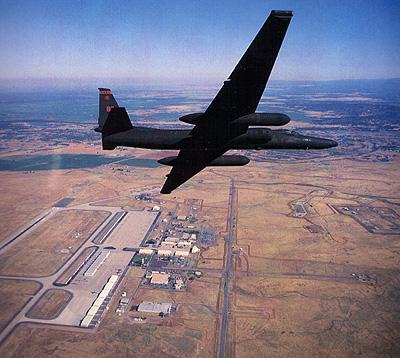
Lockheed
U-2 Spy Plane
UAVs
(Unmanned Aerial
Vehicles) and military drones have
also been used to explain away UFO reports. Although they
come in different sizes and shapes and are highly technological
devices developed for the USAF and other agencies, UAVs
and drones are remotely-operated vehicles that are incapable
of hovering in total silence.


Left:
RQ-1 Predator MAE UAV. Right: RQ-3A DarkStar Tier
III Minus
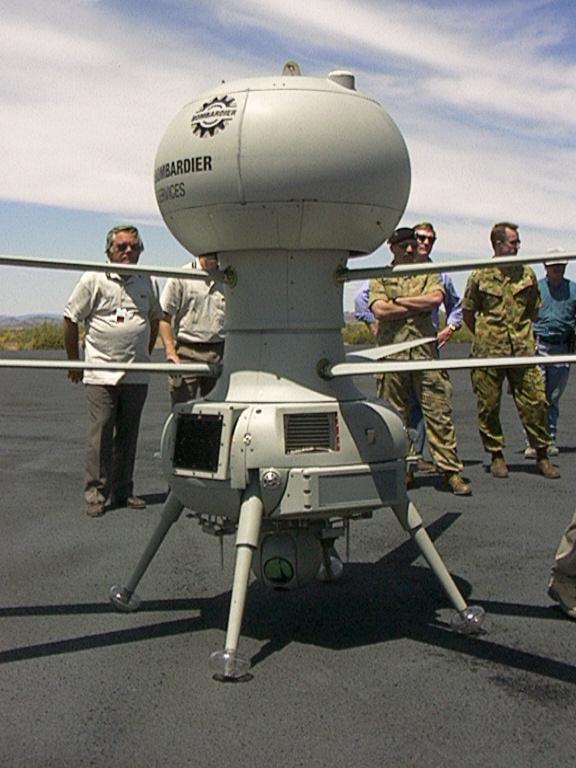

Left:
CL-327 Guardian. Right: Tacit Blue
Note
that most of these UAVs have fixed wings and do not look
anything like the types of UFOs that witnesses, worldwide,
have reported or described. Although they are exotic in
their appearance and manner of flight, these remote-controlled
vehicles do not have the same flight characteristics as
genuine UFOs and flying saucers.
|
| |
|
Drones
In
several UFO reports that I've received, there is occasional
mention of the word "Drone". It may be difficult
for some people to "believe" that UFOs exist so
they tend to rationalize what they see and eventually come
up with quick-fix explanations for the sighting(s) by saying:
"It must have been a drone!"
In
the early Fall of 2016, I was fortunate enough to witness
the flight of a Phantom 3 drone being flown by a man who
was showing it to his son. My friend Will took the next
two videos of its flight with his cell phone:
|
|
|
|
| |
|
In order to demonstrate the difference between man-made drones
and UFOs, I felt it was also important to post the following
images representing drone technology, both civilian and military
in nature. |
| |
|
Civilian
Drones
|
Military
Drones
|
|
|
|
|
2
Parrot AR.Drone 2.0 in flight
|
Military
Tactical Re-Con Drone
|
|
|
|
|
|
|
3DR
Solo Smart Drone
|
Raven
- mini-drone by Lockheed-Martin
|
|
|
|
|
|
|
Amazon
tests drone delivery through a program called PrimeAir
|
The
Russian Armed Forces Have Their Drone
|
|
|
|
|
|
|
DJI
Phantom 2 Vision+ Quadcopter with FPV HD Video Camera and
3-Axis Gimbal
|
China
is fast developing strategic and tactical unmanned aerial
vehicles.jpg
|
|
|
|
|
|
|
Drone
with a GoPro camera
|
Dual-Prop
Centerfugal Drone Prototype
|
|
|
|
|
|
|
Drone
with LED lights
|
AI's
GHOST UAV
|
|
|
|
|
|
|
Drone
used in cinematography
|
A160T
Hummingbird drone joins the US Army
|
|
|
|
|
|
|
Mini-Drone
7597
|
CIA
wants more armed drones
|
|
|
|
|
|
|
Phoblographer
Lily Drone
|
A
Navy X-47B Unmanned Combat Air System Demonstration aircraft
|
| |
|
|
|
|
Defibrillator
Drone
|
Aqua
Submersible Mini Drone
|
| |
|
|
|
|
There
is now a 'drone interceptor' to take out pesky drones
|
Aquatic
Drone
|
| |
|
|
|
|
Drone
turned into a Star Wars flyer
|
Prototype
Quadrotor with Machine Gun
|
|
|
Military
Flares
A
flare, also sometimes called a fusee, is a type of pyrotechnic
that produces a brilliant light or intense heat without
an explosion. Flares are used for signaling, illumination,
or defensive countermeasures in civilian and military applications.
Flares may be ground pyrotechnics, projectile pyrotechnics,
or parachute-suspended to provide maximum illumination time
over a large area. Projectile pyrotechnics may be dropped
from aircraft, fired from rocket or artillery, or deployed
by flare guns or handheld percussive tubes.
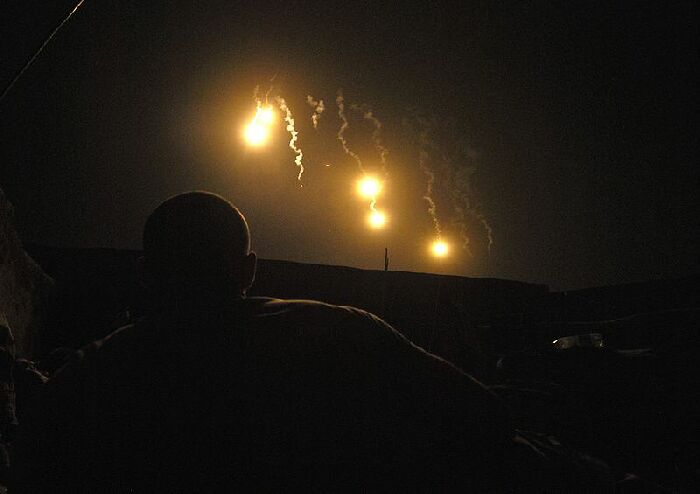
Illumination
rounds are fired during Operation Tora Arwa V in the Kandahar
province
during Operation Enduring Freedom. The illumination rounds
were fired from M777
howitzers and are used to help illuminate a certain area
the soldiers need to see.
Flares
dropped by a flight of A-10 Warthogs was the explanation
used to explain away the famous Phoenix Lights event which
was witnessed by thousands of people across the state of
Arizona on March 13, 1997.

|
 Flares
launched by an F-16 at dusk
Flares
launched by an F-16 at dusk |
 F-16
dropping flares
F-16
dropping flares |
 Flares
dropped by a military plane
Flares
dropped by a military plane |
| |
| |
|
No infringement intended. For educational purposes only.
|
|
|
